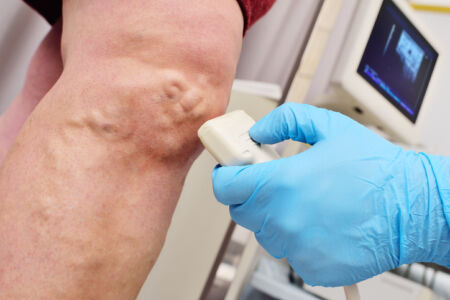
The human suffering caused by venous insufficiency (vein disease) is hardly new. The ancient Greek father of modern medicine, Hippocrates, first proposed compression wraps for twisted, painful varicose veins as an alternative to the crude and unsuccessful surgery used 2,400 thousand years ago. Ancient Egyptian writings dating back to 1550 B.C. advocated for herbal treatment of what they referred to as "serpentine windings."
Fortunately, today's vein treatment techniques
are quick and minimally invasive, allowing patients to return to their regular routine immediately with few restrictions.
Read to learn why one vein treatment method is chosen over another
At Center for Vein Restoration (CVR), our vein doctors will first do a thorough health history, physical, and diagnostic ultrasound before putting together a plan of action to treat a patient's vein disease. The ultrasound exam reveals abnormalities in the patient's venous system (veins). It serves as a road map to deciding:
At the end of every treatment plan is a one-month follow-up appointment. During this important office visit, the doctor and the patient together will review how the patient feels since vein treatment and compares it to how the patient felt before treatment.
When vein physicians are looking at the ultrasound mapping of the patient, there are different veins that they can see. Depending on what veins we are treating, this mapping will dictate what treatment modality they use.
Veins examined during an ultrasound include the following:
Choosing the correct treatment modality depends on many factors. The treatments all work, but there are different reasons for using them.
One such reason is doctor preference. Physicians may like a particular treatment because they have experienced success and patient satisfaction using it.
Thermal
Thermal methods use high levels of heat to close the vein. These include radiofrequency ablation and laser ablation. Because a local anesthetic is used during this procedure, patients who are anxious about needles or want a treatment that can be done quickly without this extra step may want to choose a different treatment method.
The advantage of thermal treatment for vein disease is that the physician has a high degree of control over where the heat is applied. Because a straight, rigid fiber delivers heat, this method best treats long, straight veins.
Sclerotherapy
Sclerotherapy is an excellent option for treating veins that are twisted, asymmetric, and close to the skin. This minimally invasive procedure uses a medication called a sclerosant which displaces the blood in the vein, irritates the vein wall, and closes the diseased vein. This method is quick and requires no anesthetic.
The disadvantage of this procedure is that the physician does not have a high degree of control over where the medication goes. Because the medication has a "shaving cream" consistency, it freely fills in the area. The benefit is that the medicine closes the vein efficiently and effectively.
Adhesive
Medical glue seals the damaged vein using this method, forcing blood to flow to nearby healthy veins. The procedure is quick, and no anesthesia is needed.
Vein experts define tortuous veins as veins that are not in a straight line but have twists and turns. Because the tool used during radiofrequency and laser treatment requires a straight shot to float up the vein, thermal methods are not the choice for tortuous veins. Sclerotherapy and adhesives are better treatment options for these asymmetric veins.
Doctors at CVR never remove a saphenous vein. Closure methods are always chosen for saphenous veins. Veins considered for removal are large, ropey-like varicose veins that can be seen just under the skin. While these bulging varicose veins can also be treated using a closure technique, patients who tell their doctor that their varicose veins are "ugly, painful, and want them gone fast" are a good candidate for a vein removal technique called ambulatory phlebectomy. The cosmetic result is immediate, and patients are delighted with the results afterward.
During ambulatory phlebectomy, the skin is numbed. Tiny incisions are made through which the vein is removed. No stitches are needed; only a band-aid is used.
This is an excellent example of physician preference. When a patient describes being very bothered by the pain and aesthetics caused by a bulging vein, CVR vein physicians will choose phlebectomy.
It's a common misunderstanding is that varicose veins are cosmetic treatments. They are not. For patients experiencing aching, itchy, and burning legs caused by vein disease, removing these veins are a matter of medical necessity. It is not just "cosmetic." For this reason, vein treatment is covered by most insurance carriers.
A vein treatment fact that CVR physicians wish every patient knew is that resting after a vein procedure is the opposite of what is recommended. Patients are encouraged to walk after treatment to promote good circulation and prevent clots from forming in the legs.
Scheduling with the nation’s leader in vein care is easier than ever! Schedule a consultation online or call 240-965-3915 to meet with a board-certified physician trained in all modern, state-of-the-art vein closure modalities. Visit centerforvein.com for more information.
The sooner you meet with a CVR physician, the sooner you can look and feel better!